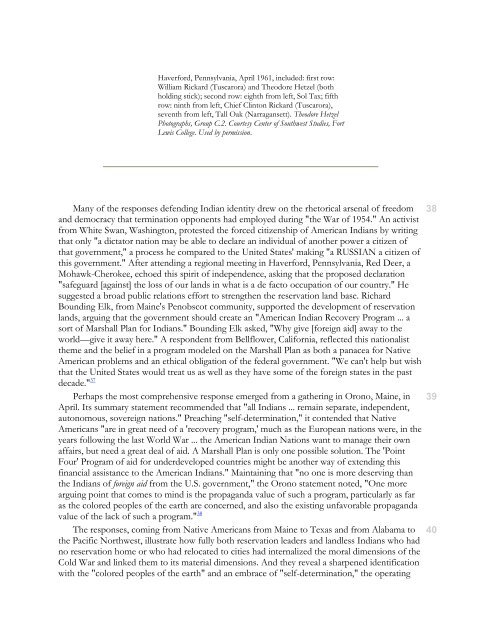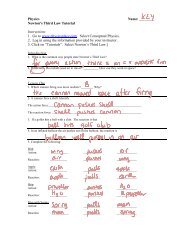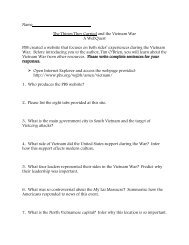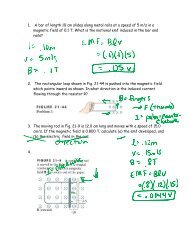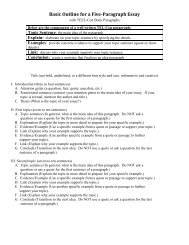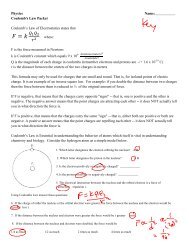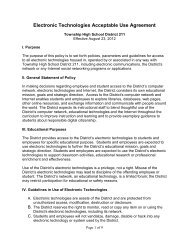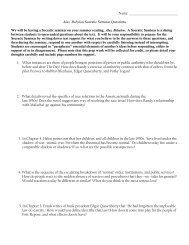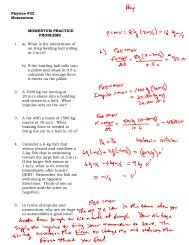Lesson Plan: Indian Activism during the Cold War - Schaumburg ...
Lesson Plan: Indian Activism during the Cold War - Schaumburg ...
Lesson Plan: Indian Activism during the Cold War - Schaumburg ...
Create successful ePaper yourself
Turn your PDF publications into a flip-book with our unique Google optimized e-Paper software.
Haverford, Pennsylvania, April 1961, included: first row:William Rickard (Tuscarora) and Theodore Hetzel (bothholding stick); second row: eighth from left, Sol Tax; fifthrow: ninth from left, Chief Clinton Rickard (Tuscarora),seventh from left, Tall Oak (Narragansett). Theodore HetzelPhotographs, Group C.2. Courtesy Center of Southwest Studies, FortLewis College. Used by permission.Many of <strong>the</strong> responses defending <strong>Indian</strong> identity drew on <strong>the</strong> rhetorical arsenal of freedom 38and democracy that termination opponents had employed <strong>during</strong> "<strong>the</strong> <strong>War</strong> of 1954." An activistfrom White Swan, Washington, protested <strong>the</strong> forced citizenship of American <strong>Indian</strong>s by writingthat only "a dictator nation may be able to declare an individual of ano<strong>the</strong>r power a citizen ofthat government," a process he compared to <strong>the</strong> United States' making "a RUSSIAN a citizen ofthis government." After attending a regional meeting in Haverford, Pennsylvania, Red Deer, aMohawk-Cherokee, echoed this spirit of independence, asking that <strong>the</strong> proposed declaration"safeguard [against] <strong>the</strong> loss of our lands in what is a de facto occupation of our country." Hesuggested a broad public relations effort to streng<strong>the</strong>n <strong>the</strong> reservation land base. RichardBounding Elk, from Maine's Penobscot community, supported <strong>the</strong> development of reservationlands, arguing that <strong>the</strong> government should create an "American <strong>Indian</strong> Recovery Program ... asort of Marshall <strong>Plan</strong> for <strong>Indian</strong>s." Bounding Elk asked, "Why give [foreign aid] away to <strong>the</strong>world—give it away here." A respondent from Bellflower, California, reflected this nationalist<strong>the</strong>me and <strong>the</strong> belief in a program modeled on <strong>the</strong> Marshall <strong>Plan</strong> as both a panacea for NativeAmerican problems and an ethical obligation of <strong>the</strong> federal government. "We can't help but wishthat <strong>the</strong> United States would treat us as well as <strong>the</strong>y have some of <strong>the</strong> foreign states in <strong>the</strong> pastdecade." 37Perhaps <strong>the</strong> most comprehensive response emerged from a ga<strong>the</strong>ring in Orono, Maine, in 39April. Its summary statement recommended that "all <strong>Indian</strong>s ... remain separate, independent,autonomous, sovereign nations." Preaching "self-determination," it contended that NativeAmericans "are in great need of a 'recovery program,' much as <strong>the</strong> European nations were, in <strong>the</strong>years following <strong>the</strong> last World <strong>War</strong> ... <strong>the</strong> American <strong>Indian</strong> Nations want to manage <strong>the</strong>ir ownaffairs, but need a great deal of aid. A Marshall <strong>Plan</strong> is only one possible solution. The 'PointFour' Program of aid for underdeveloped countries might be ano<strong>the</strong>r way of extending thisfinancial assistance to <strong>the</strong> American <strong>Indian</strong>s." Maintaining that "no one is more deserving than<strong>the</strong> <strong>Indian</strong>s of foreign aid from <strong>the</strong> U.S. government," <strong>the</strong> Orono statement noted, "One morearguing point that comes to mind is <strong>the</strong> propaganda value of such a program, particularly as faras <strong>the</strong> colored peoples of <strong>the</strong> earth are concerned, and also <strong>the</strong> existing unfavorable propagandavalue of <strong>the</strong> lack of such a program." 38The responses, coming from Native Americans from Maine to Texas and from Alabama to 40<strong>the</strong> Pacific Northwest, illustrate how fully both reservation leaders and landless <strong>Indian</strong>s who hadno reservation home or who had relocated to cities had internalized <strong>the</strong> moral dimensions of <strong>the</strong><strong>Cold</strong> <strong>War</strong> and linked <strong>the</strong>m to its material dimensions. And <strong>the</strong>y reveal a sharpened identificationwith <strong>the</strong> "colored peoples of <strong>the</strong> earth" and an embrace of "self-determination," <strong>the</strong> operating


